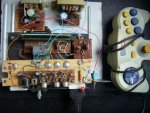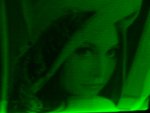Benm
0
- Joined
- Aug 16, 2007
- Messages
- 7,896
- Points
- 113
Somehow i think that will get on my nerves... the noise from a 15.625 Khz flyback in a crt irritates me at times, and this is wizzing around at half that frequency. Then again, proper galvo's can be quite noisy too, depending on what you are scanning.
I think its a creative idea though. Sure, its a tuning fork with a mirror attached, but as long as it actually works, why not?
I've never tried to use scanners as a projector, but somehow i think it might be possible with and ordinary galvo set... perhaps even right off the VGA analog X and Y signals with a (pretty fast) correction amp in between. In a real life system you would scan zig-zag rather than each line left to right, but that only reduces performance by half at most.
I think its a creative idea though. Sure, its a tuning fork with a mirror attached, but as long as it actually works, why not?
I've never tried to use scanners as a projector, but somehow i think it might be possible with and ordinary galvo set... perhaps even right off the VGA analog X and Y signals with a (pretty fast) correction amp in between. In a real life system you would scan zig-zag rather than each line left to right, but that only reduces performance by half at most.






